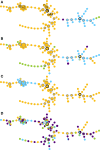Within-Flock Population Dynamics of Dichelobacter nodosus
- PMID: 28484704
- PMCID: PMC5401886
- DOI: 10.3389/fvets.2017.00058
Within-Flock Population Dynamics of Dichelobacter nodosus
Abstract
Footrot causes 70-90% of lameness in sheep in Great Britain. With approximately 5% of 18 million adult sheep lame at any one time, it costs the UK sheep industry £24-84 million per year. The Gram-negative anaerobe Dichelobacter nodosus is the causative agent, with disease severity influenced by bacterial load, virulence, and climate. The aim of the current study was to characterize strains of D. nodosus isolated by culture of swabs from healthy and diseased feet of 99 ewes kept as a closed flock over a 10-month period and investigate persistence and transmission of strains within feet, sheep, and the flock. Overall 268 isolates were characterized into strains by serogroup, proline-glycine repeat (pgr) status, and multi-locus variable number tandem repeat analysis (MLVA). The culture collection contained 87 unique MLVA profiles and two major MLVA complexes that persisted over time. A subset of 189 isolates tested for the virulence marker aprV2 were all positive. The two MLVA complexes (76 and 114) comprised 62 and 22 MLVA types and 237 and 28 isolates, respectively. Serogroups B, and I, and pgrB were associated with MLVA complex 76, whereas serogroups D and H were associated with MLVA complex 114. We conclude that within-flock D. nodosus evolution appeared to be driven by clonal diversification. There was no association (P > 0.05) between serogroup, pgr, or MLVA type and disease state of feet. Strains of D. nodosus clustered within sheep and were transmitted between ewes over time. D. nodosus was isolated at more than one time point from 21 feet, including 5 feet where the same strain was isolated on two occasions at an interval of 1-33 weeks. Collectively, our results indicate that D. nodosus strains persisted in the flock, spread between sheep, and possibly persisted on feet over time.
Keywords: Dichelobacter nodosus; MLVA; footrot; persistence; strain variation.
Figures

References
-
- Beveridge WIB. Foot-Rot in Sheep: A Transmissible Disease Due to Infection with Fusiformis nodosus (n. sp.). Studies on Its Cause, Epidemiology, and Control. Bulletin No. 140. Melbourne, VIC: CSIRO; (1941).
-
- Nieuwhof GJ, Bishop SC. Costs of the major endemic diseases of sheep in Great Britain and the potential benefits of reduction in disease impact. Anim Sci (2005) 81(1):23–9.10.1079/ASC41010023 - DOI
-
- Stewart DJ. An electron microscopic study of Fusiformis nodosus. Res Vet Sci (1973) 14(1):132–4. - PubMed
Grants and funding
LinkOut - more resources
Full Text Sources
Other Literature Sources
Research Materials

